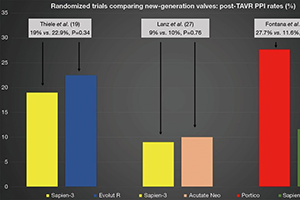Overcoming the transcatheter aortic valve replacement Achilles heel: conduction abnormalities—a systematic review
Abstract
Background: Transcatheter aortic valve replacement (TAVR) has been shown to be a good alternative to surgery for treating severe symptomatic aortic stenosis (AS) across the whole range of surgical risk patients. Whereas most periprocedural TAVR complications have significantly decreased over time, conduction disturbances remain high. Approaches to decrease this shortcoming are under continuous investigation.
Methods: We conducted a comprehensive systematic review focusing on modifiable factors impacting post-TAVR conduction disturbances, such as balloon aortic valvuloplasty (BAV), type of new-generation transcatheter valve and implantation depth (ID). Search strategies were based on the best available evidence from each study. Primary endpoints were post-TAVR need of permanent pacemaker implantation (PPI) and new onset left bundle branch block (NOLBBB).
Results: Data from 35 studies with a total of 29,982 patients were analyzed. BAV did not negatively impact PPI rates after TAVR. In propensity-matched and randomized trials, the Evolut R valve was associated with slightly higher rates of PPI compared to the Sapien 3 valve (25% vs. 19.2% in propensity-matched studies; 22.9% vs. 19% in a randomized trial). The Acurate Neo valve was associated with the lowest PPI rate in observational studies (10.4%), but a PPI rate similar to Sapien 3 was reported in a randomized trial (10% vs. 9%). The Portico valve system was associated with a higher PPI risk (PPI rate of 21.9% and 27.7% in propensity-matched and randomized studies, respectively). ID and its relation with the membranous septum (MS) length predicted post-TAVR conduction disturbances, particularly with Evolut R and Sapien 3 valves.
Conclusions: Pre-TAVR BAV did not increase the risk of conduction disturbances post-TAVR. Among the new-generation transcatheter valve systems, Sapien 3 and Acurate Neo valves were associated with the lowest PPI rates followed by the Evolut and Portico valves. A deeper valve implantation and a shorter MS length determined an increased risk of conduction disturbances post-TAVR.
Cover






